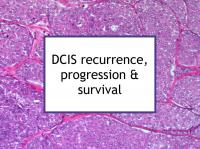Below we summarize data published since 2015 concerning outcomes of patients with ductal carcinoma in situ (DCIS). However, please note that individual outcomes can vary depending on numerous factors and the data represents snapshots from studies that were conducted under a variety of circumstances.
Furthermore, most studies that calculate survival do not present the results as simple percentages. Therefore, the numbers below are somewhat inconsistent and far from complete or definitive and should not be used to calculate your likely DCIS outcome. However, the statistics are useful in getting a general idea of DCIS prognosis and to compare outcomes depending on treatment and other factors. For example, the data makes clear that breast conserving surgery (lumpectomy) for DCIS typically has a better prognosis when accompanied by radiotherapy than if radiotherapy is omitted.
Definition of recurrence & survival terms
Local recurrence-free survival indicates that no DCIS or invasive breast cancer was found in the same breast, lymph nodes or chest wall (and there were no distance metastases). Overall survival means that no death occurred from any cause (including non-breast cancer-specific causes).
DCIS recurrence & survival data
Patient and treatment characteristics → Likelihood of outcome
Survival after diagnosis of DCIS
- Treated DCIS → 95% ten-year overall survival
- No surgery, radiotherapy or other treatment after DCIS is diagnosed with biopsy → 76% ten-year overall survival
Type of treatment
- Mastectomy only → 97% to 98% ten-year local recurrence-free survival
- Lumpectomy only → 74% to 95% ten-year local recurrence-free survival
- Lumpectomy + radiotherapy → 86% to 98% ten-year local recurrence-free survival
Large DCIS tumor size (≥ 4 cm)
- Lumpectomy only → 59% ten-year local recurrence-free survival
- Lumpectomy + radiotherapy, no boost → 83% ten-year local recurrence-free survival
- Lumpectomy + radiotherapy with boost → 84% ten-year local recurrence-free survival
Surgical margins
- Lumpectomy only with surgical margins < 5 mm → 57% five-year local recurrence-free survival
- Lumpectomy only with surgical margins ≥5 mm → 86% to 88% five-year local recurrence-free survival
Tumor grade
- DCIS tumor grade I/II → ten-year 88% local recurrence-free survival
- DCIS tumor grade III → ten-year 82% local recurrence-free survival
Age at diagnosis
- Diagnosed at age ≤ 50 → 68% five-year local recurrence-free survival
- Diagnosed at age > 50 → 86% five-year local recurrence-free survival
Below are links to recent studies concerning this topic. Please also see our article on DCIS prognosis, which describes factors that drive outcomes in DCIS patients.
